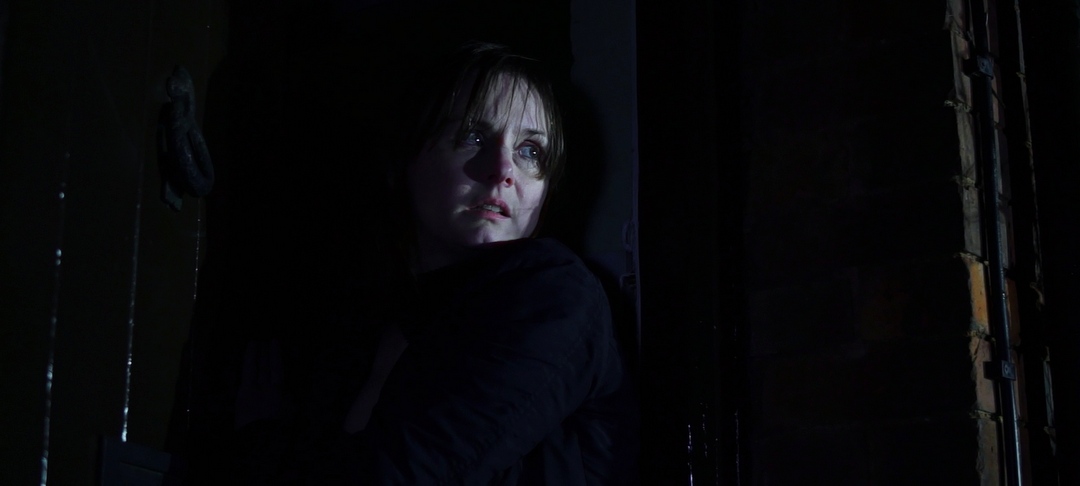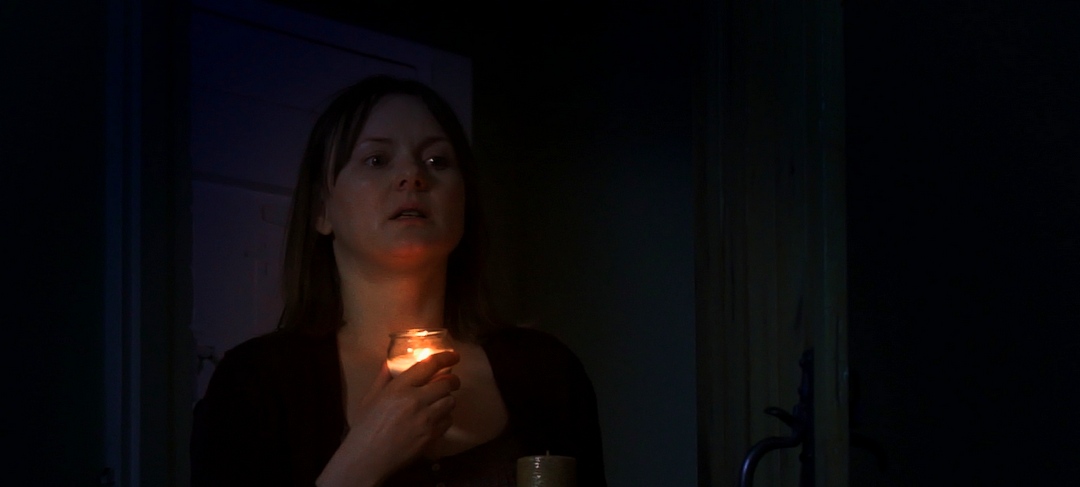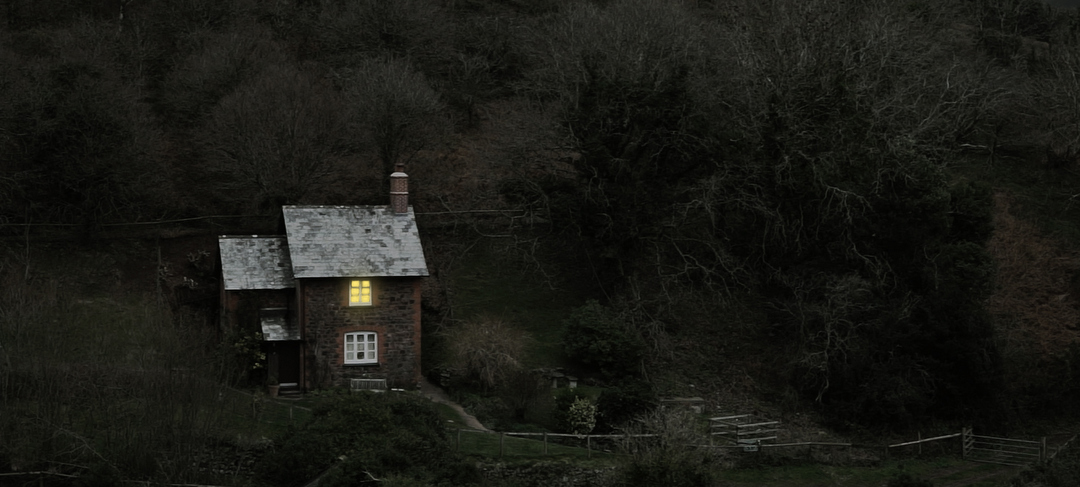
Tracey Ann Wood as Joyce contemplates the night in ‘The Redeeming’ Dir. by Brian Barnes
indieactivity: Introduction?
Brian: My (Brian Barnes) debut no-budget feature film, psychological thriller ’The Redeeming’, plays its world premiere at the Horror-on-Sea Film Festival in Southend, Essex, UK on Sunday 28th January 2018. It will roll out on VOD in 12 countries on the next day. ‘The Redeeming’ is an absorbing cat-and-mouse thriller that plays out over the course of one night. Its twists and turns keep you glued to the screen, because the characters are so volatile that you just never know what’s going to happen next. We’ve made the film for fans of recent films like ‘Get Out’, ‘Blue Ruin’, ‘It Comes At Night’ and ‘Don’t Breathe’, and classics like ‘Psycho’, ‘Misery’ and ‘The Shining’.
Disturbed single mother Joyce is hiding out from a raging storm in a remote cottage when mysterious young stranger John knocks on her door looking for help. Despite her misgivings, she lets him in, but neither of them is sure they can trust the other. Joyce comes to realise she must protect her home from this interloper, but her struggle to hold onto her sanity could doom them both. After a fight and chase through the house, a shocking twist reveals just how fragile Joyce’s reality has become. ‘The Redeeming’ forces viewers to acknowledge that we all believe what we need to believe in order to survive.
The film features mesmerising central performances by the 2 leads and was filmed partly by candlelight during ‘the stormiest period of weather the UK has experienced for at least 20 years’. Cast and crew were trapped in a remote Somerset (SW England) farmhouse, with rising floodwaters cutting us off physically and mentally. We all channelled this isolation and disturbed atmosphere to create the intense claustrophobia of the film.
indieactivity: How did you develop your film?
Brian: In late 2013, I directed a commercial for a car finance company. The budget for that was so large that I could hold a major open casting session at the world famous Ealing Studios to find the best actors available. The moment Tracey Ann Wood (Joyce) walked into the room, I knew I had found a very special actress. Immediately after the audition session, I rang my regular writing partner Roger Thomas and told him about the wonderful actress I had discovered. I also told him about a location I had access to and asked him to combine those elements into a story.
He got started straight away while I continued to work on the commercial. By the time we had wrapped the commercial, the script was in good enough shape for me to be able to offer parts to Tracey Ann Wood, Ryan Wichert (John) and Robert Blackwood (Dr Hadley) in the feature. They were all actors in the commercial, so effectively the commercial casting had been my feature casting!

Tracey Ann Wood as Joyce tries to spook John by holding up a candle to her face in ‘The Redeeming’ Dir. by Brian Barnes
indieactivity: How was it financed?
Brian: In 2012 and 2013, I toured film festivals with my multiple-award-winning psychological horror short film ‘The Urge’. That attracted some interest from fans, who asked me how they could help me and my filmmaking. Only half-seriously, I said, “Give me money to make a feature film!” Surprisingly, they did, even though at the time I had no proper feature project that I could move forward with. They liked me and my ambition and were backing me, not a project. They gave me only a small amount of money, but it was definitely enough to get the ball rolling.
Significantly, the real impact was psychological – it showed me that I had a potential audience for my films and it galvanised me to move forward with a feature sooner rather than later. Moreover, because I effectively used the Roger Corman/Robert Rodriguez technique of making a list of my available resources and then designing the story around those, we didn’t need to raise any money for the film. We simply “reverse budgeted” – in other words, we looked at how much money we had in our pockets and worked out how to make the film for that amount of money.
indieactivity: How long was pre-production?
Brian: We started writing the script in August 2013 and had a draft I was happy to take into production by October. I announced the start of pre-production by the end of October and we were shooting by the end of January 2014. It was a comparatively relaxed pre-production, because we already had the location, actors and key props (as they had been on my resources list I gave to Roger Thomas in the beginning).
Most of pre-production was spent on refining the script, working out the logistics of getting cast and crew down to the location from our London base, finding additional crew, and rehearsing with the actors. In the event, the location I thought we had locked down fell through just 3 weeks from shooting, so I had to find another location in double quick time. As it turned out, the second location we found was so much better than the original. It was one of those ‘happy accidents’ of filmmaking!
indieactivity: What was your rehearsal process and period?
Brian: I have done some training as an actor myself and I took a part in a play at a fringe theatre here in London. This gives me as a director a great understanding of actors’ processes and helps me to help them to discover their characters and work on their performances. More importantly, I am a massive believer in the old adage that 80 percent of good directing is getting the casting right.
Tracey Ann Wood (Joyce) has played on the main stage at the National Theatre here in London, which is the UK’s premier theatre, and Ryan Wichert has starred in a Grimme-Preis (equivalent to an Emmy) nominated TV show in Germany, so they are both highly accomplished and experienced actors. This meant that much of the rehearsal process was simply lighting the blue touch paper, letting them play the scenes out and observing them closely. I’d then discuss with them the discoveries we had all made about the characters and the story in Roger Thomas’s excellent script. We spent a total of 4 intensive days in rehearsal, spread out over a period of about 2 months. That may not sound like a lot, but this was a no-budget production and it actually represented half as much time as we shot for, so you could say it was a lot of rehearsal time!
The important thing was that we knew that we would be very short of time while we were actually shooting, so we wouldn’t have any time to discuss and discover on the live set. The rehearsal process enabled us to nail down so many of the issues in advance that we were only doing small tweaks while shooting

The house at night, in ‘The Redeeming’ Dir. by Brian Barnes
indieactivity: You shot the film in how many days. How long were your days?
Brian: We were on location for 10 days and we shot the film in 9 of those days straight through without a break. We worked pretty much 8am to 8pm every day. There were only one or two days where we went over time and we wrapped by 9pm on those late nights. We had to shoot an average of 9 pages per day, but there were 3 days where we shot 10, 11, and 12 pages on each day to create enough slack in the schedule to spend more time on some trickier scenes.
We had a few tremendous advantages to help us speed through the shoot. Firstly, because the actors are very experienced in theatre, they were effectively word perfect for every scene, and there were no fluffs requiring re-takes or pickups. This also meant that we could chop and change between scenes at a moment’s notice for the sake of expediency. For example, we shot the living room scenes all in one direction in the room and then flopped the room to shoot the coverage. This saved us an enormous amount of time, but required the actors to have really amazing continuity, as they were shooting the second half of a scene up to 24 hours after the first half. Our second great advantage was the time of year we were shooting at.
n the UK in January we lose the light at about 3.30pm, so the night exteriors could all be done at about 4pm and look like the depths of midnight. This was helped even more by the remoteness of the location, as there was absolutely no light pollution. Furthermore, most of the film is set at night, but it takes place in interiors, so we could just black out the windows and shoot during the day, saving time again. Another great advantage was that we were all living and working in the same space, so getting to work in the morning was as simple as walking into the next room. And every set-up was a “walkaway” each night – we didn’t have to pack any kit away, as we’d be back in the same room the next morning. It made us an incredibly efficient team.
indieactivity: Did the tight shooting schedule make it harder or easier? How did it affect performance?
Brian: Obviously, every director wants more time and more money, but you find a way to work with what you have. There’s a very powerful moment in ‘The Redeeming’ involving a bit of body language between Joyce (Tracey Ann Wood) and John (Ryan Wichert), which was improvised by Tracey literally moments before we shot the scene.
Not only does that show how magnificent an actress she is, but it also shows that despite the incredible time pressures we were all under, I was still able to keep the actors relaxed and playful enough to be generating new material all the time. That’s down to our intensive rehearsal process, but also due to my insistence that filmmaking is all about performance and I will do everything I can to protect the actors and enable their performances.
Without performance, you have nothing. (And no, I can’t be more specific about the moment I am talking about, as it would spoil that scene for you!)
indieactivity: How important was the location?
Brian: It was fundamental to the success of the film. As Tracey Ann Wood (Joyce) said, “I’ve had a ball playing Joyce! The house almost represented her mind, and the different rooms different parts of her personality.” Ryan Wichert (John) told me that the house was the most remote place he had ever been to. It truly was in the middle of nowhere. That meant that we had no distractions and we were all entirely focussed on the making of the film. While we were there, the nearby area was inundated with the worst flooding for between 20 and 50 years (depending on who you listen to!). Either way, we were stuck in the house and couldn’t get out. That isolation fed into the claustrophobia of the film and heightens the excitement of watching the film for the audience.
indieactivity: What was the experience like of working with such a small shooting crew (?)?
Brian: We had a team of 2 on camera – Director of Photography Matt Aucott and focus puller Alex Williams – sound recordist Graeme Willetts, EPK camera operator Kathrin Benoehr and then myself and the 2 lead actors. It was a small team, by anyone’s reckoning.
What I loved about it was that we were a small family. We all lived and worked together, but more importantly we also ate dinner together every night and swapped stories and beers across the kitchen table. It was like being in an episode of ‘The Waltons’ and was the best shooting experience of my life!
indieactivity: The film looks stunning. How did you get such a good look when shooting so fast?
Brian: We shot partly by candlelight. Matt Aucott our Director of Photography was keen to go ‘Barry Lyndon’ on us and it pays off really well. Unlike in Kubrick’s day, shooting by candlelight on modern cameras is really quite easy. It gave us a great ‘baked-in’ look, which we were able to enhance slightly in grading.
indieactivity: What were the advantages and disadvantages in the way you worked?
Brian: The massive advantage of the way we worked is that we’ve managed to make a feature film for almost no money. And it’s turned out really well. One review describes ‘The Redeeming’ as ‘psychological thriller at its best’ and another reviewer gave the film 4 stars (out of 5). Using the very best actors we could find, but also making sure they were keen and hungry enough to want to get on board with our no frills production method was also key.
Deliberately compressing the shooting schedule into effectively one long week meant that cast and crew only had to take a week off their day jobs and so had a minimal impact on their lives. Designing the story around elements that we already had available was also fundamental to our success. It meant that we could go straight into production once we locked the script, as we didn’t need to wait around for things to fall into place. The main disadvantage was the time pressure.
But I’ve read an interview with Christopher Nolan where he complained that he didn’t have enough time or money on ‘Interstellar’ and that was a US$150m budget! So, in some ways, if it’s good enough for him to be pressed for time, then it’s OK for me. To be honest, I loved the momentum that we generated because we knew we had so little time to get the film done and we were just relentlessly shooting all the time.
indieactivity: You shot the film in January 2014, but it’s not premiering until January 2018. Why has it taken so long to get the film out?
filmmaker: M‘The Redeeming’ is my first feature film and so I really wasn’t sure what to expect from the experience of making it. When I was planning the film, I met a few people who had made features before and asked them for advice. Effectively, they all said that shooting a feature is pretty much like planning and shooting a lot of short films back to back. I’ve made 25 short films and I can absolutely agree with this description in terms of the pre-production and shooting.
However, the massive, massive difference is in post-production. With a short film, you may well have 4 or 5 scenes and you can’t really play with them much to change your film. With ‘The Redeeming’, we had over 120 scenes and we could have placed them in any order we liked. That adds an exponential power to your story-telling that you can’t know about until you experience it for yourself. As it was my first feature, I was determined to explore these possibilities to learn as much as I could from this opportunity. Consequently, we spent about 18 months tinkering with the cut.
We also held 3 test screenings to get feedback on the work-in-progress and it took a lot of time to absorb the notes and work out how we could address them. Once we locked picture, we then spent another 15 months working on the sound design, because I am a major believer that sound is more than half of your finished film. Overall, unless you’ve been through it yourself, I don’t think it’s possible to grasp just how humongous a job of work making a feature film actually is. It is without question the hardest thing I have ever done in my life! What this all means is that we will premiere the film exactly 4 years to the day that we were shooting the film.
I checked through the schedule, and on the date of our premiere four years previously, we were shooting 2 deliciously key scenes in the film. (One of those scenes appears in the trailer, but the other one you’ll have to wait to see in the film.) I’m looking forward to being able to talk about those scenes at the premiere!
indieactivity: Where can we find out more about the film?
Brian: Our website has loads of behind the scenes videos and interviews with the cast and crew. You can follow us on Twitter and find us on Facebook
Chidinma Ifunanyachi goes from Nollywood to Hollywood
Actress and writer from the deprived South-East London, went from Camberwell to Nollywood and now to Hollywood.
Apple TV picks up “Dismissed” by Aysha Scott After it Hit a Million Views
Single mother entrepreneur from South-East London, built up an empire from scratch.
MOEDER Oscar® Qualified Drama Based on MH17 Airline Disaster
OSCAR® Qualified MOEDER tells a story tragedy on the Ukrainian-Russian border
Nate & John Oscar® qualified Animation Short Directed by Jumai Yusuf
NATE & JOHN heartwarming animation short qualifies for the 97th Academy® Awards









